MERCEDES-BENZ SLC-Class 2017 R172 Workshop Manual
Manufacturer: MERCEDES-BENZ, Model Year: 2017, Model line: SLC-Class, Model: MERCEDES-BENZ SLC-Class 2017 R172Pages: 294, PDF Size: 7.28 MB
Page 51 of 294
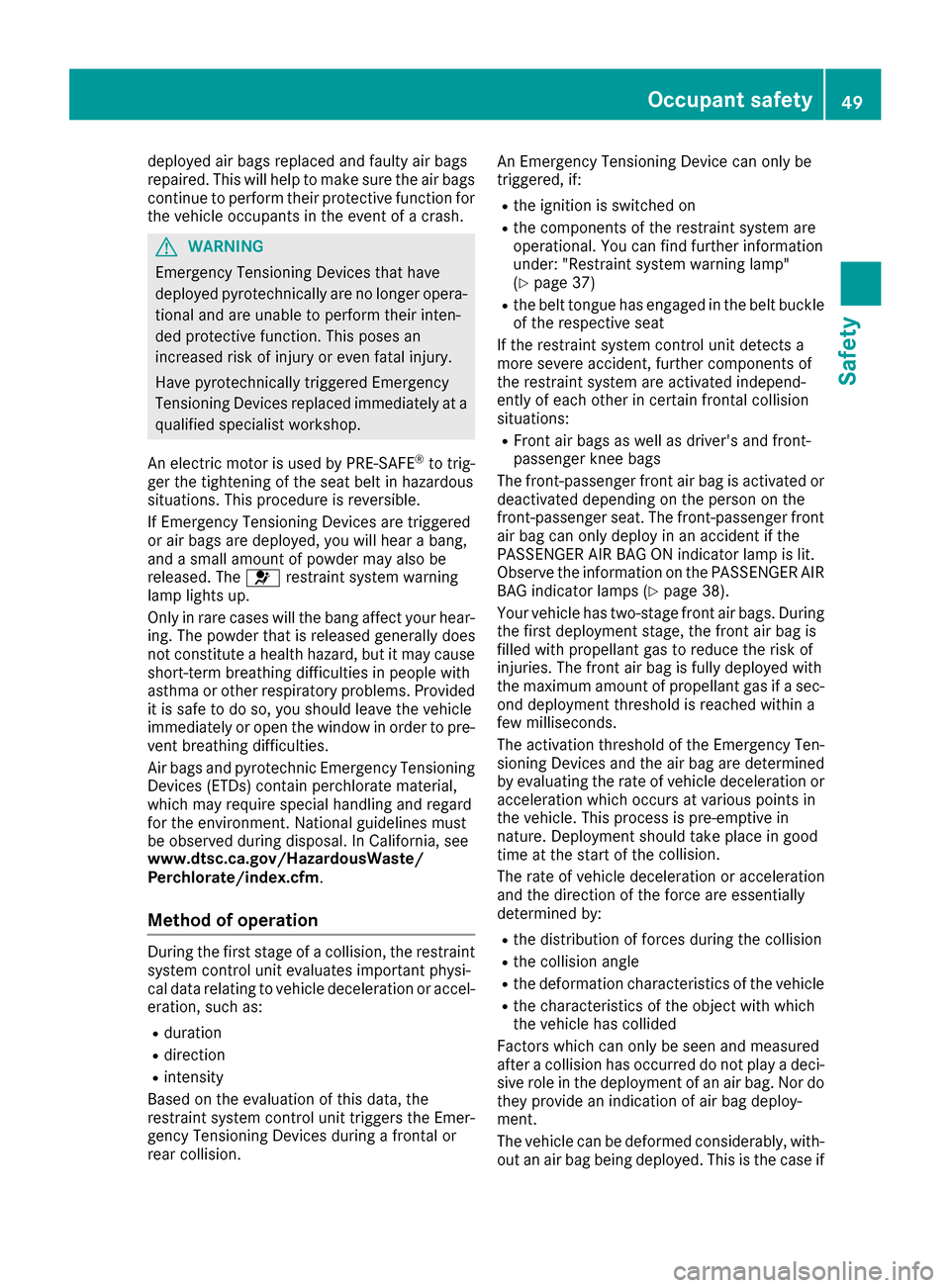
deployed air bags replaced and faulty air bags
repaired. This will help to make sure the air bags
continue to performtheir protective function for
the vehicle occupants in the event of acrash.
GWARNING
Emergenc yTensioning Devices that have
deployed pyrotechnically are no longer opera-
tional and are unable to performt heir inten-
ded protective function .This poses an
increased risk of injury or even fatal injury.
Have pyrotechnically triggered Emergency
Tensioning Devices replaced immediately at a
qualified specialist workshop.
An electric moto risused by PRE-SAFE
®to trig-
ger the tightenin gofthe seat belt in hazardous
situations. This procedure is reversible.
If Emergenc yTensioning Devices are triggered
or air bags are deployed, you will hear abang,
and asmall amount of powder may also be
released. The 6restraint system warning
lamp lights up.
Only in rare cases will the bang affect your hear-
ing. The powder that is released generally does
not constitute ahealth hazard, but it may cause
short-term breathin gdifficulties in people with
asthma or other respiratory problems. Provided
it is safe to do so, you should leave the vehicle
immediately or open the window in order to pre-
vent breathin gdifficulties.
Air bags and pyrotechnic Emergenc yTensioning
Devices (ETDs) contain perchlorate material,
which may require special handling and regard
for the environment. National guidelines must
be observed during disposal. In California, see
www.dtsc.ca.gov/HazardousWaste/
Perchlorate/index.cfm .
Method of operation
Duringthe first stage of acollision, the restraint
system control unit evaluates important physi-
cal data relatin gtovehicle deceleration or accel-
eration ,such as:
Rduration
Rdirection
Rintensity
Based on the evaluation of this data, the
restraint system control unit triggers the Emer-
genc yTensioning Devices during afrontal or
rear collision. An Emergenc
yTensioning Devic ecan only be
triggered, if:
Rthe ignition is switched on
Rthe component softhe restraint system are
operational. You can find further information
under: "Restraint system warning lamp"
(
Ypage 37)
Rthe belt tongue has engaged in the belt buckle
of the respective seat
If the restraint system control unit detects a
more severe accident, further component sof
the restraint system are activated independ-
ently of each other in certain frontal collision
situations:
RFronta ir bags as well as driver'sa nd front-
passenger knee bags
The front-passenger fronta ir bag is activated or
deactivated dependin gonthe person on the
front-passenger seat. The front-passenger front
air bag can only deploy in an accidentift he
PASSENGER AIR BAGONi ndicator lamp is lit.
Observe the information on the PASSENGER AIR
BAGi ndicator lamps (
Ypage 38).
Your vehicle has two-stage fronta ir bags. During
the first deployment stage, the fronta ir bag is
filled with propellant gas to reduce the risk of
injuries. The fronta ir bag is fully deployed with
the maximum amount of propellant gas if asec-
ond deployment threshold is reached within a
few milliseconds.
The activation threshold of the Emergenc yTen-
sionin gDevices and the air bag are determined
by evaluating the rate of vehicle deceleration or
acceleration which occurs at various point sin
the vehicle. This processisp re-emptive in
nature. Deploymen tshould take place in good
time at the start of the collision.
The rat
e of vehicle deceleration or acceleration
and the direction of the forcea re essentially
determined by:
Rthe distribution of forces during the collision
Rthe collision angle
Rthe deformation characteristic softhe vehicle
Rthe characteristic softhe objec twith which
the vehicle has collided
Factors which can only be seen and measured
after acollision has occurred do not play adeci-
sive role in the deployment of an air bag. Nor do
they provide an indication of air bag deploy-
ment.
The vehicle can be deformed considerably, with-
out an air bag being deployed. This is the case if
Occupant safety49
Safety
Z
Page 52 of 294
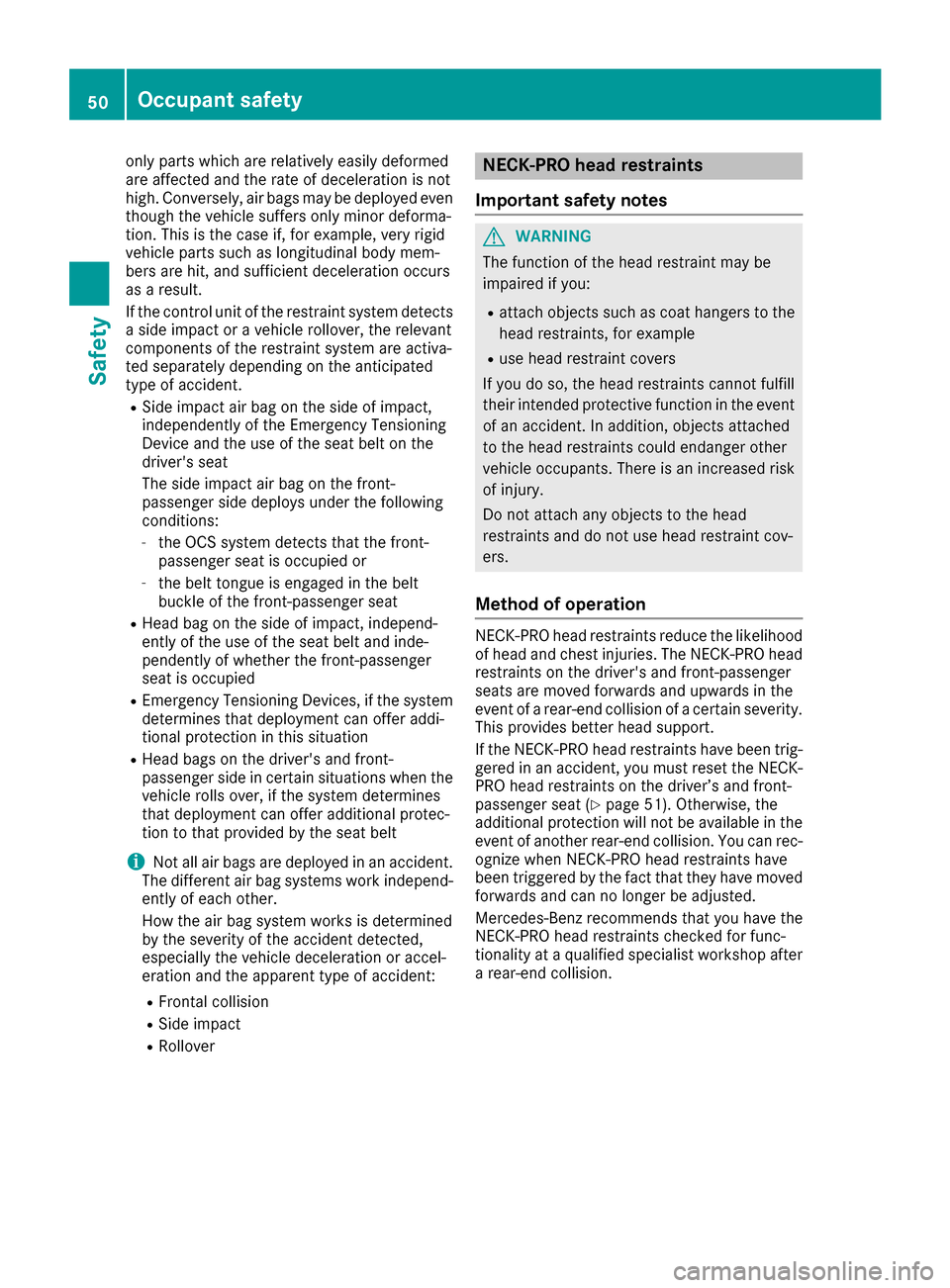
only parts which are relatively easily deformed
are affected and the rate of deceleration is not
high. Conversely, air bags may be deployed even
though the vehicle suffers only minor deforma-
tion. This is the case if, for example, very rigid
vehicle parts such as longitudinal body mem-
bers are hit, and sufficient deceleration occurs
asaresult.
If the control unit of the restraint system detects
as ide impact or avehicle rollover, the relevant
components of the restraint system are activa-
ted separately depending on the anticipated
type of accident.
RSide impact air bag on the side of impact,
independently of the Emergency Tensioning
Device and the use of the seat belt on the
driver's seat
The side impact air bag on the front-
passenger side deploys under the following
conditions:
-the OCS system detect sthat the front-
passenger seat is occupied or
-the belt tongue is engaged in the belt
buckle of the front-passenger seat
RHead bag on the side of impact, independ-
ently of the use of the seat belt and inde-
pendently of whether the front-passenger
seat is occupied
REmergency TensioningD evices, if the system
determines that deployment can offer addi-
tional protection in this situation
RHead bags on the driver's and front-
passenger side in certain situations when the
vehicle rolls over, if the system determines
that deployment can offer additional protec-
tion to that provided by the seat belt
iNot all air bags are deployed in an accident.
The different air bag systems work independ-
ently of each other.
How the air bag system works is determined
by the severity of the accident detected,
especially the vehicle deceleration or accel-
eration and the apparent type of accident:
RFrontal collision
RSide impact
RRollover
NECK-PRO head restraints
Important safety notes
GWARNING
The function of the head restraint may be
impaired if you:
Rattach object ssuch as coat hangers to the
head restraints, for example
Ruse head restraint covers
If you do so, the head restraint scannot fulfill
their intended protective function in the event of an accident.Ina ddition, objectsattached
to the head restraint scould endanger other
vehicle occupants. There is an increased risk
of injury.
Do not attach any object stothe head
restraint sand do not use head restraint cov-
ers.
Method of operation
NECK-PRO head restraint sreduce the likelihood
of head and chest injuries. The NECK-PRO head
restraint sonthe driver's and front-passenger
seats are moved forwards and upwards in the
event of arear-end collision of acertain severity.
This provides better head support.
If the NECK-PRO head restraint shave been trig-
gered in an accident,y ou must reset the NECK-
PRO head restraint sonthe driver’s and front-
passenger seat (
Ypage 51). Otherwise, the
additional protection will not be available in the event of another rear-end collision. You can rec-
ognize when NECK-PRO head restraint shave
been triggered by the fact that they have moved
forwards and can no longer be adjusted.
Mercedes-Benz recommends that you have the
NECK-PRO head restraint schecked for func-
tionality at aqualified specialist workshop after
ar ear-end collision.
50Occupant safety
Safety
Page 53 of 294
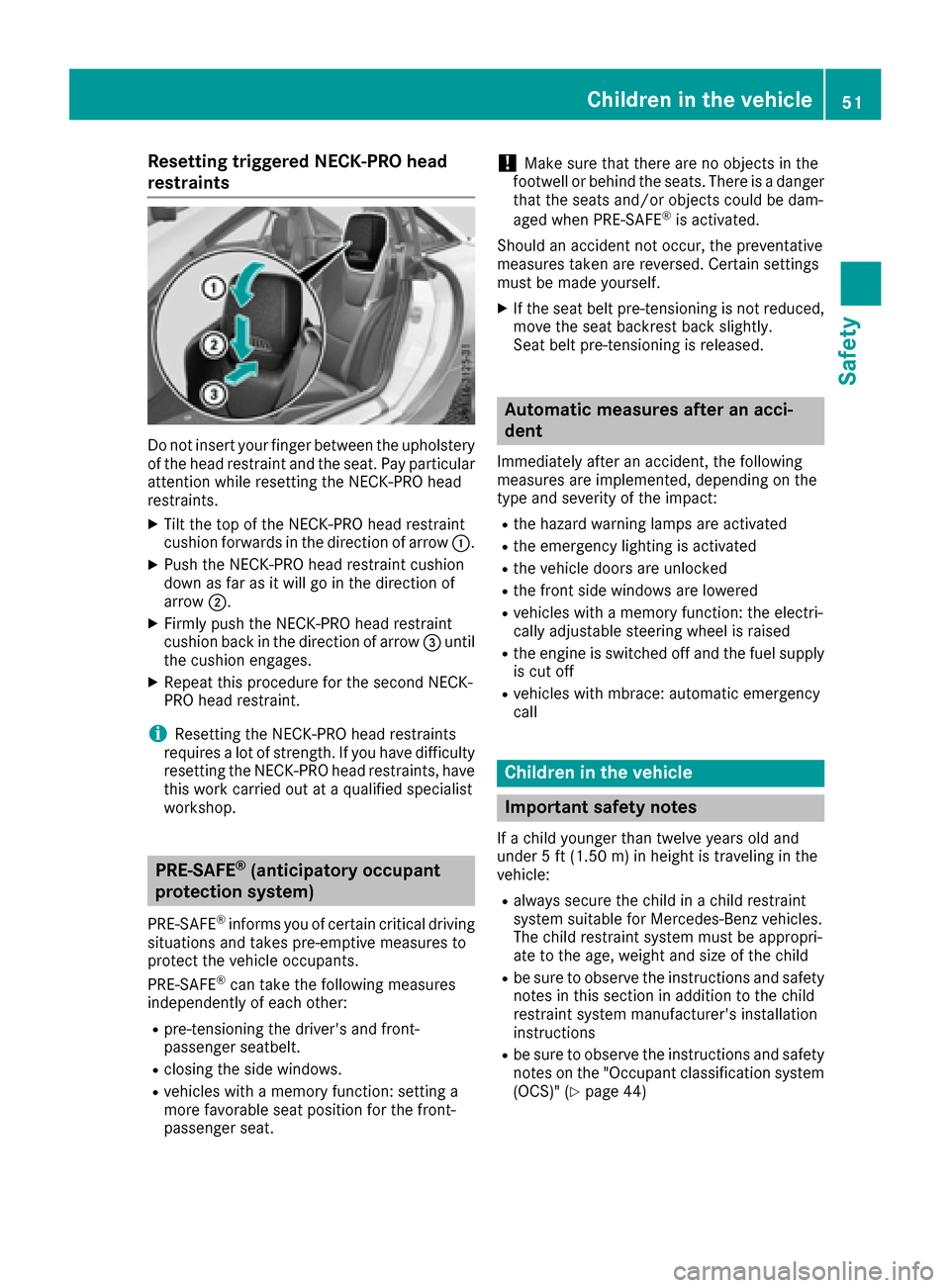
Resetting triggeredNECK-PRO head
restraints
Do not insert your finger between the upholstery of the hea drestraint and the seat. Payp articular
attention whil eresetting the NECK-PROh ead
restraints.
XTilt the top of the NECK-PROh eadr estraint
cushio nforward sinthe direction of arrow :.
XPush the NECK-PROh eadr estraint cushion
dow nasfar as it will go in the direction of
arrow ;.
XFirmly push the NECK-PROh eadr estraint
cushio nbackint he direction of arrow =until
the cushio nengages.
XRepea tthis procedure for the second NECK-
PROh eadr estraint.
iResetting the NECK-PROh eadr estraints
requires alot of strength. If yo uhaved ifficulty
resetting the NECK-PROh eadr estraints, have
this work carrie doutataq uali fied specialist
workshop.
PRE-SAFE®(anticipatory occupant
protection system)
PRE-SAFE®informs yo uofcertain critical driving
situations and take spre-emptive measures to
protect the vehicl eoccupants.
PRE-SAFE
®can take the following measures
independentl yofeacho ther:
Rpre-tensioning the driver' sand front-
passenger seatbelt.
Rclosing the sid ewindows.
Rvehicles with amemory function: setting a
more favorabl eseatp osition for the front-
passenger seat.
!Make sure that there are no objects in the
footwell or behind the seats. There is adanger
that the seats and/or objects could be dam-
aged when PRE-SAFE
®is activated.
Should an accident not occur, the preventative
measures take nare reversed. Certai nsettings
mus tbem adey ourself.
XIf the sea tbeltp re-tensioning is not reduced,
move the sea tbackrest back slightly.
Seatb eltp re-tensioning is released.
Automatic measures after an acci-
dent
Immediately afte ranaccident, the following
measures are implemented, depending on the
typ eand severity of the impact:
Rthe hazard warning lamps are activated
Rthe emergency lighting is activated
Rthe vehicl edoors are unlocked
Rthe front sid ewindow sare lowered
Rvehicles with amemory function: the electri-
cally adjustabl esteering wheel is raised
Rthe engine is switched off and the fue lsuppl y
is cut off
Rvehicles with mbrace: automatic emergency
call
Childrenint he vehicle
Important safety notes
Ifac hild younger than twelve years olda nd
under 5ft(1.50 m) in height is traveling in the
vehicle:
Ralways secur ethe child in achild restraint
systems uitabl efor Mercedes-Benz vehicles.
The child restraint systemm ustbea ppropri-
ate to the age, weight and size of the child
Rbe sure to observe the instructions and safety
note sint hissectio nina dditiontot he child
restraint systemm anufacturer's installation
instructions
Rbe sure to observe the instructions and safety
note sont he "Occupant classification system
(OCS) "(
Ypage 44)
Children in the vehicle51
Safety
Z
Page 54 of 294
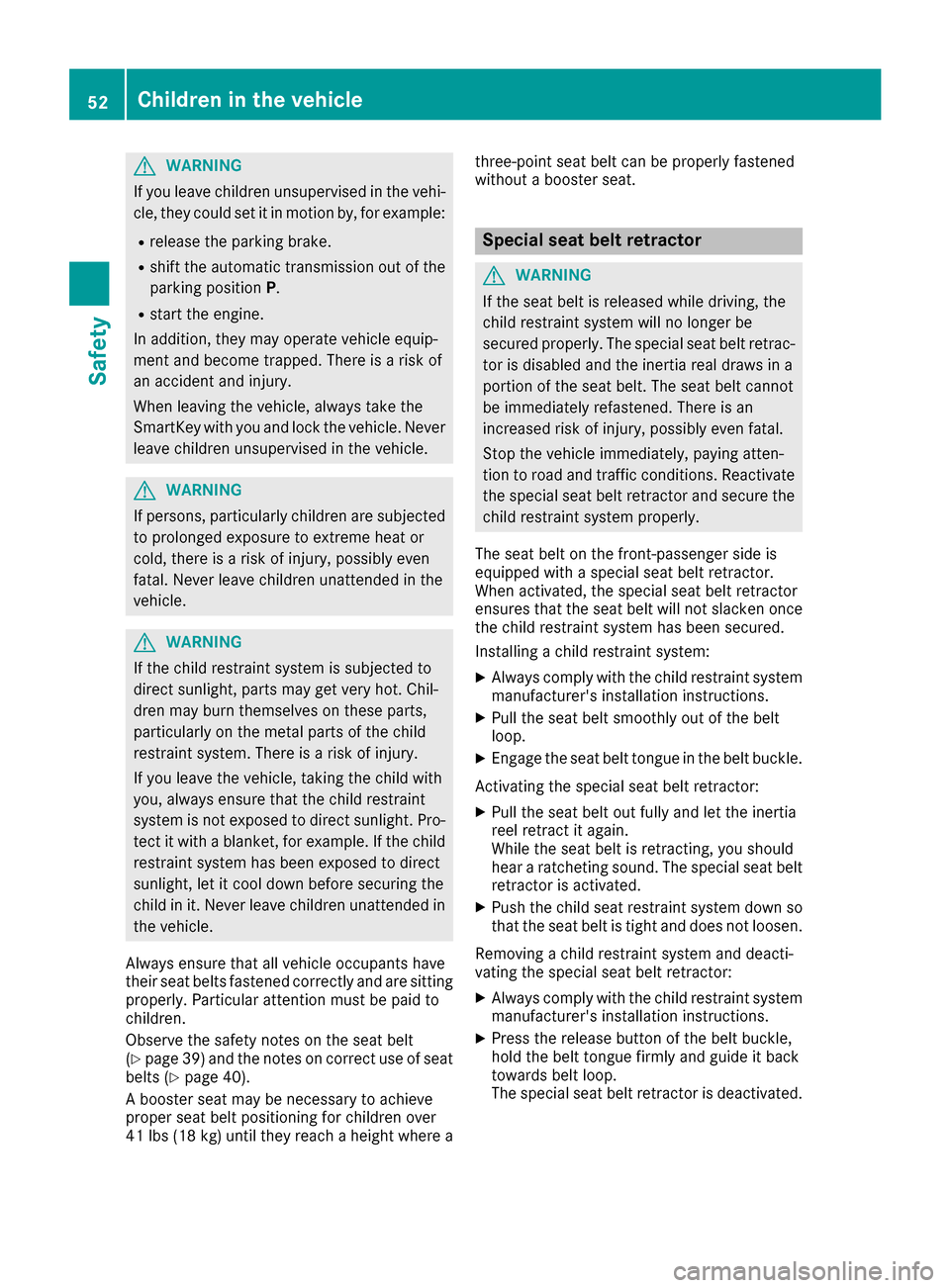
GWARNING
If you leave children unsupervised in the vehi-
cle, they coul dset it in motion by, for example:
Rrelease the parking brake.
Rshift the automatic transmission out of the
parking position P.
Rstart the engine.
In addition, they may operate vehiclee quip-
ment and become trapped. There is arisk of
an accident and injury.
When leaving the vehicle, alway stake the
SmartKey with you and lock the vehicle. Never
leave children unsupervised in the vehicle.
GWARNING
If persons, particularl ychildren are subjected
to prolonged exposure to extreme heato r
cold, there is arisk of injury ,possibly even
fatal .Never leave children unattended in the
vehicle.
GWARNING
If the child restraint system is subjected to
direct sunlight, parts may get very hot. Chil-
dren may burn themselves on these parts,
particularl yonthe metal parts of the child
restraint system. There is arisk of injury.
If you leave the vehicle, taking the child with
you ,alway sensure that the child restraint
system is not exposedtod irect sunlight. Pro-
tect it with ablanket, for example. If the child
restraint system has been exposedtod irect
sunlight, let it cool downb efore securing the
child in it. Never leave children unattended in
the vehicle.
Always ensure that all vehicleo ccupants have
their seat belts fastened correctly and are sitting
properly.P articular attention must be pai dto
children.
Observe the safety notes on the seat belt
(
Ypag e39) and the notes on correct use of seat
belts (Ypag e40).
Ab ooster seat may be necessary to achieve
propers eat beltp ositioning for children over
41 lbs (18 kg )until they reach aheight where a three-point seat beltc
an be properly fastened
without abooster seat.
Special seat bel tretractor
GWARNING
If the seat beltisr eleased while driving, the
child restraint system wil lnolonger be
secure dproperly.T he special seat beltr etrac-
tor is disable dand the inertia real draw sina
portion of the seat belt. The seat beltc annot
be immediatel yrefastened. There is an
increased risk of injury,p ossibly even fatal.
Stop the vehiclei mmediately, paying atten-
tion to road and traffic conditions. Reactivate
the special seat beltr etractor and secure the
child restraint system properly.
The seat beltont he front-passenge rside is
equipped with aspecial seat beltr etractor.
When activated, the special seat beltr etractor
ensure sthat the seat beltw illn ot slacken once
the child restraint system has been secured.
Installing achild restraint system:
XAlways comply with the child restraint system
manufacturer's installation instructions.
XPul lthe seat belts moothly out of the belt
loop.
XEngage the seat beltt ongue in the beltbuckle.
Activating the special seat beltr etractor:
XPullthe seat belto ut fullyand let the inertia
reel retract it again.
Whil ethe seat beltisr etracting, you should
hear aratcheting sound .The special seat belt
retractor is activated.
XPush the child seat restraint system downs o
that the seat beltist ight and does not loosen.
Removing achild restraint system and deacti-
vating the special seat beltr etractor:
XAlways comply with the child restraint system
manufacturer's installation instructions.
XPress the release button of the beltb uckle,
hold the beltt ongue firmly and guide it back
toward sbeltl oop.
The special seat beltr etractor is deactivated.
52Children in the vehicle
Safety
Page 55 of 294
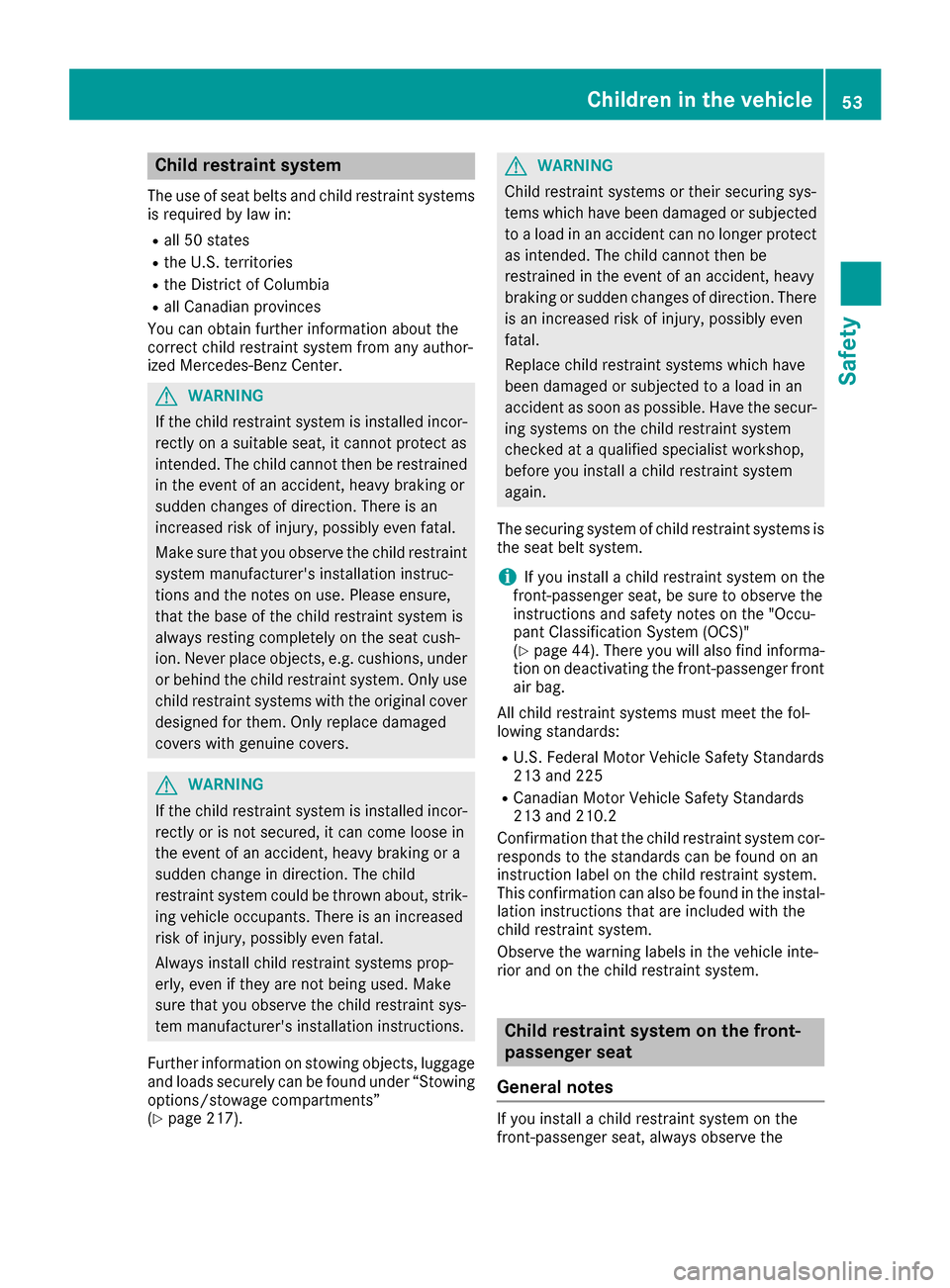
Child restraint system
The use of seat beltsand child restraint systems
is required by law in:
Rall 50 states
Rth eU .S.t erri tories
RtheD istrict of Columbia
Rall Canadian provinces
You can obtain further informatio nabout the
correc tchild restraint system from any author-
ize dM ercedes-Ben zCenter.
GWARNING
If th echild restraint system is installed incor-
rectly on asuitable seat,itc annotprotect as
intended. The child canno tthe nber estrained
in th eevent of an accident, heavyb raking or
suddenc hanges of direction.T hereisan
increased ris kofinjury, possibly eve nfatal.
Makes ure that you observ ethe child restraint
system manufacturer'si nstallationinstruc-
tions and th enotes on use. Pleasee nsure,
that th ebase of th echild restraint system is
always restin gcompletely on th eseat cush-
ion.N ever placeo bjects, e.g.cushions, under
or behindt hechild restraint system. Only use
child restraint systems witht heoriginal cover
designe dfor them. Only replace damaged
covers withg enuine covers.
GWARNING
If th echild restraint system is installed incor-
rectly or is no tsecured, it can com eloosei n
th ee vent of an accident, heavyb raking or a
suddenc hang eind irection.T he child
restraint system coul dbethrown about,s trik-
ing vehicle occupants .Thereisani ncreased
ris kofi njury, possibly eve nfatal.
Always install child restraint systems prop-
erly, eve niftheya re no tbeingu sed. Make
sure that you observ ethe child restraint sys-
te mm anufacturer'si nstallationinstructions.
Further informatio nonstowingo bjects, luggage
and loads securely can be foun dunde r“Stowi ng
options/stowage compartments”
(
Ypage 217).
GWARNING
Child restraint systems or their securin gsys-
tems whichh ave been damaged or subjected
to aload in an accidentc an no longer protect
as intended. The child canno tthe nb e
restraine dintheevent of an accident, heavy
braking or suddenc hanges of direction.T here
is an increased ris kofinjury, possibly even
fatal.
Replacec hild restraint systems whichh ave
been damaged or subjected to aload in an
accidentass oon as possible. Hav ethe secur-
ing systems on th echild restraint system
checked at aqualified specialist workshop,
before you install achild restraint system
again.
The securin gsystem of child restraint systems is
th es eat belt system.
iIf you install achild restraint system on the
front-passenger seat,bes ure to observethe
instructionsa nd safety note sonthe"Occu-
pantC lassificatio nSyste m(OCS)"
(
Ypage 44). Therey ou will also findinforma-
tio nond eactivatin gthe front-passenger front
air bag.
All child restraint systems must mee tthe fol-
lowings tandards:
RU.S. Federal Motor Vehicle SafetyS tandards
21 3a nd 225
RCanadian Motor Vehicle SafetyS tandards
21 3a nd 210.2
Confirmation that th echild restraint system cor-
responds to th estandards can be foun donan
instruction label on th echild restraint system.
This confir mation c
an also be foun
dintheinstal-
lation instructionst hata re included witht he
child restraint system.
Observ ethe warning labels in th evehicle inte-
rior and on th echild restraint system.
Child restraint system on th efront-
passengers eat
General notes
If you install achild restraint system on the
front-passenger seat,a lways observethe
Children in th evehicle53
Safety
Z
Page 56 of 294
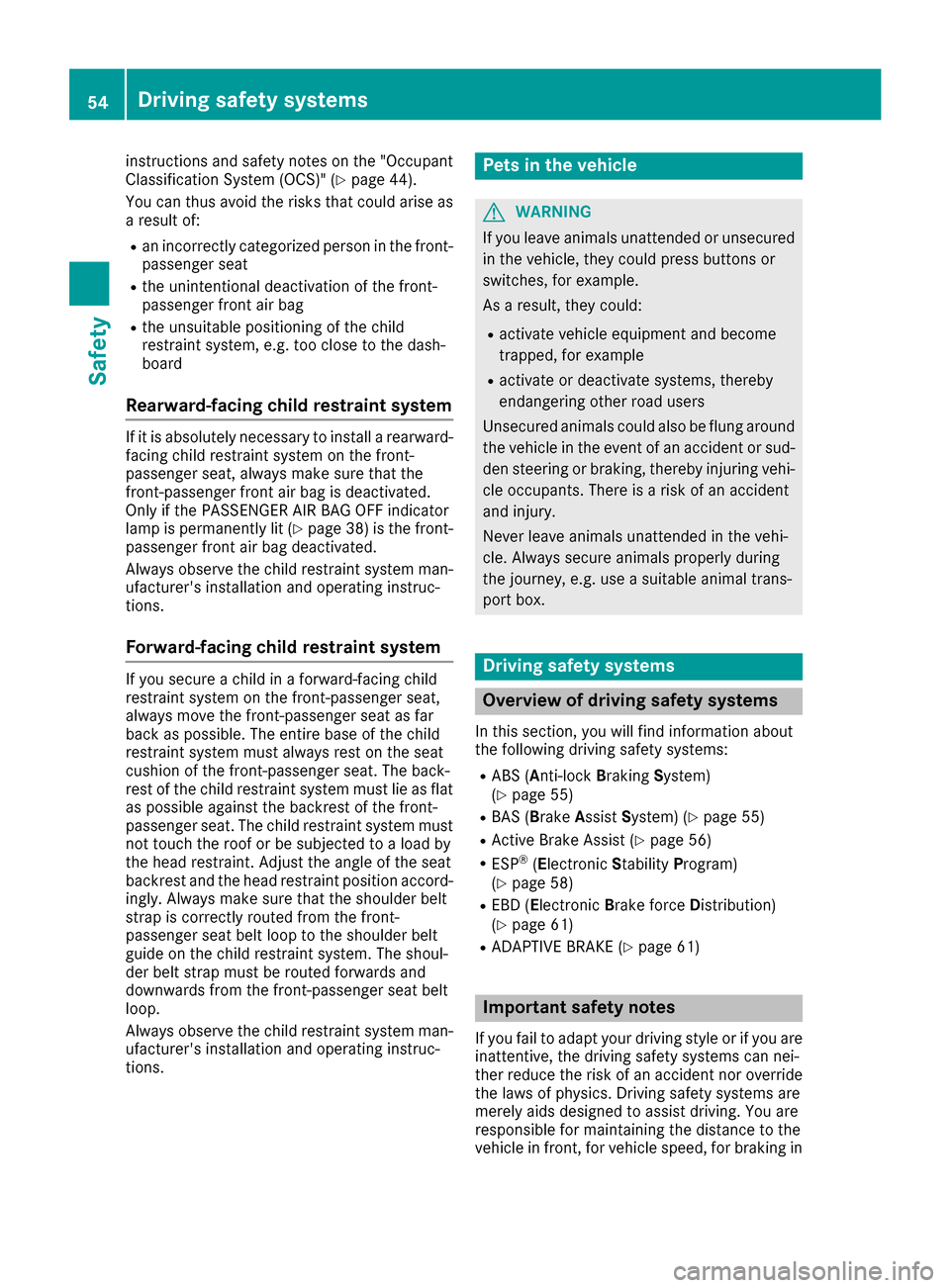
instructions and safetynotes on the "Occupant
Classification System (OCS)" (Ypage 44).
You can thus avoid the riskst hat could arise as
ar esult of:
Ran incorrectly categorized personint he front-
passenger seat
Rthe unintentional deactivatio nofthe front-
passenger front air bag
Rthe unsuitable positionin gofthe child
restraint system, e.g. too clos etothe dash-
board
Rearward-facing child restraint system
If it is absolutely necessary to install arearward-
facin gchild restraint system on the front-
passenger seat, always make sure that the
front-passenge rfront air bag is deactivated.
Only if the PASSENGER AI RBAG OFF indicator
lamp is permanently lit (
Ypage 38) is the front-
passenger front air bag deactivated.
Always observe the child restraint system man-
ufacturer'si nstallation and operating instruc-
tions.
Forward-facing child restraint system
If you secur eachild in aforward-facin gchild
restraint system on the front-passenge rseat,
always move the front-passenge rseat as far
back as possible.T he entire base of the child
restraint system must always rest on the seat
cushio nofthe front-passenge rseat. The back-
rest of the child restraint system must lie as flat
as possible against the backrest of the front-
passenger seat. The child restraint system must
not touc hthe roof or be subjected to aload by
the head restraint .Adjust the angle of the seat
backrest and the head restraint position accord- ingly. Always make sure that the shoulder belt
strap is correctly routed fromt he front-
passenger seat belt loop to the shoulder belt
guide on the child restraint system. The shoul-
der belt strap must be routed forwards and
downwards fromt he front-passengerseat belt
loop.
Always observe the child restraint system man-
ufacturer'si nstallation and operating instruc-
tions.
Pets in th evehicle
GWARNING
If you leave animals unattended or unsecured
in the vehicle, the ycould press buttons or
switches, for example.
As aresult,t heyc ould:
Ractivatev ehicle equipmenta nd become
trapped, for example
Ractivateord eactivatesystems, thereby
endangeringo ther road users
Unsecure danimals could also be flung around
the vehicle in the eventofana ccident or sud-
den steeringorb raking, thereby injuring vehi-
cle occupants. There is arisk of an accident
and injury.
Never leave animals unattended in the vehi-
cle. Always secur eanimals properly during
the journey, e.g. use asuitable animal trans-
port box.
Driving safety systems
Overview of driving safety systems
In this section, you will findi nformation about
the followingd rivingsafetysystems:
RABS(Anti-lock Braking System)
(Ypage 55)
RBA S(Brake Assist System) (Ypage 55)
RActiveBrakeA ssist (Ypage 56)
RESP®(Electronic StabilityProgram)
(Ypage 58)
REB D( Electronic Bra ke force Distribution)
(Ypage 61)
RADAPTIVE BRAKE (Ypage 61)
Important safety notes
If you fail to adapt your drivings tyle or if you are
inattentive, the drivings afetysystems can nei-
the rreducet he risk of an accident nor override
the laws of physics .Drivings afetys ystems are
merely aids designed to assist driving. You are
responsible for maintainin gthe distanc etothe
vehicle in front ,for vehicle speed, for braking in
54Driving safety systems
Safety
Page 57 of 294
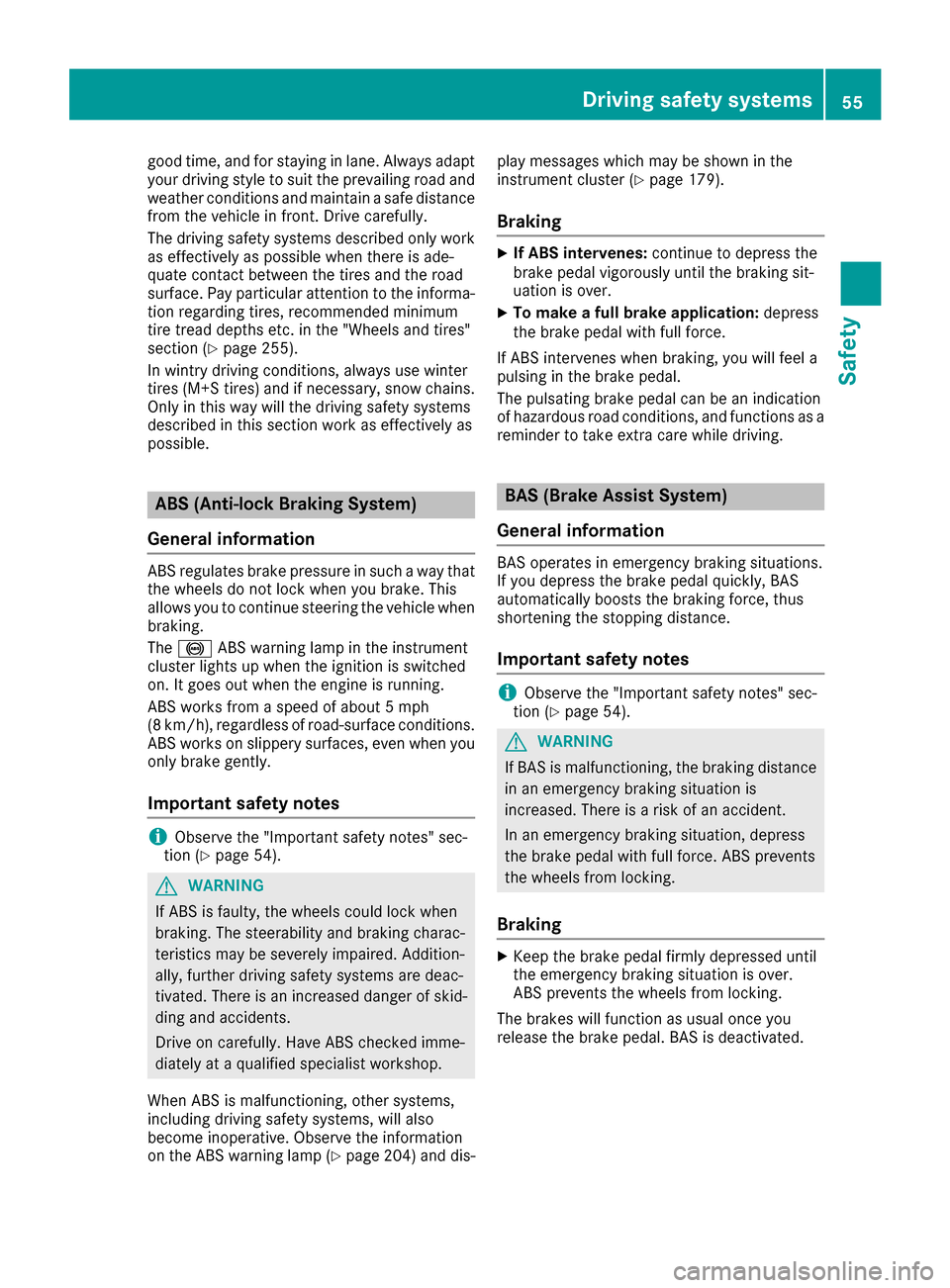
good time, and for staying in lane. Always adapt
your driving style to suit the prevailing road and
weather conditions and maintainasafe distance
from the vehicle in front.D rive carefully.
The driving safety systems described only work
as effectively as possible when there is ade-
quate contact between the tires and the road
surface. Pay particular attention to the informa-
tion regarding tires, recommended minimum
tire tread depths etc. in the "Wheels and tires"
section (
Ypage 255).
In wintry driving conditions, always use winter
tires (M+S tires) and if necessary, snow chains.
Only in this way will the driving safety systems
described in this section work as effectively as
possible.
ABS (Anti-lock Braking System)
General information
ABS regulates brake pressure in such away that
the wheels do not lock when you brake. This
allows you to continue steering the vehicle when
braking.
The ! ABS warning lamp in the instrument
cluster lights up when the ignition is switched
on. It goes out when the engine is running.
ABS works from aspeed of about 5mph
(8 km/h), regardless of road-surface conditions.
ABS works on slippery surfaces, even when you
only brake gently.
Important safety notes
iObserve the "Important safety notes" sec-
tion (Ypage 54).
GWARNING
If ABS is faulty, the wheels could lock when
braking. The steerability and braking charac-
teristics may be severely impaired. Addition-
ally,f urther driving safety systems are deac-
tivated. There is an increased danger of skid-
ding and accidents.
Drive on carefully. Have ABS checked imme-
diately at aqualified specialist workshop.
When ABS is malfunctioning, other systems,
including driving safety systems, will also
become inoperative. Observe the information
on the ABS warning lamp (
Ypage 204) and dis- play messages which may be shown in the
instrument cluster (
Ypage 179).
Braking
XIf ABS intervenes:
continue to depress the
brake pedal vigorously until the braking sit-
uation is over.
XTo make afull brake application: depress
the brake pedal with full force.
If ABS intervenes when braking, you will feel a
pulsing in the brake pedal.
The pulsating brake pedal can be an indication
of hazardous road conditions, and functions as a reminder to take extr acare while driving.
BAS (Brake Assist System)
General information
BAS operates in emergencyb raking situations.
If you depress the brake pedal quickly, BAS
automatically boosts the braking force, thus
shortening the stopping distance.
Important safety notes
iObserve the "Important safety notes" sec-
tion (Ypage 54).
GWARNING
If BAS is malfunctioning, the braking distance
in an emergencyb raking situation is
increased. There is arisk of an accident.
In an emergencyb raking situation, depress
the brake pedal with full force. ABS prevents
the wheels from locking.
Braking
XKeep the brake pedal firmly depressed until
the emergencyb raking situation is over.
ABS prevent sthe wheels from locking.
The brakes will function as usual once you
release the brake pedal. BAS is deactivated.
Driving safety systems55
Safety
Z
Page 58 of 294
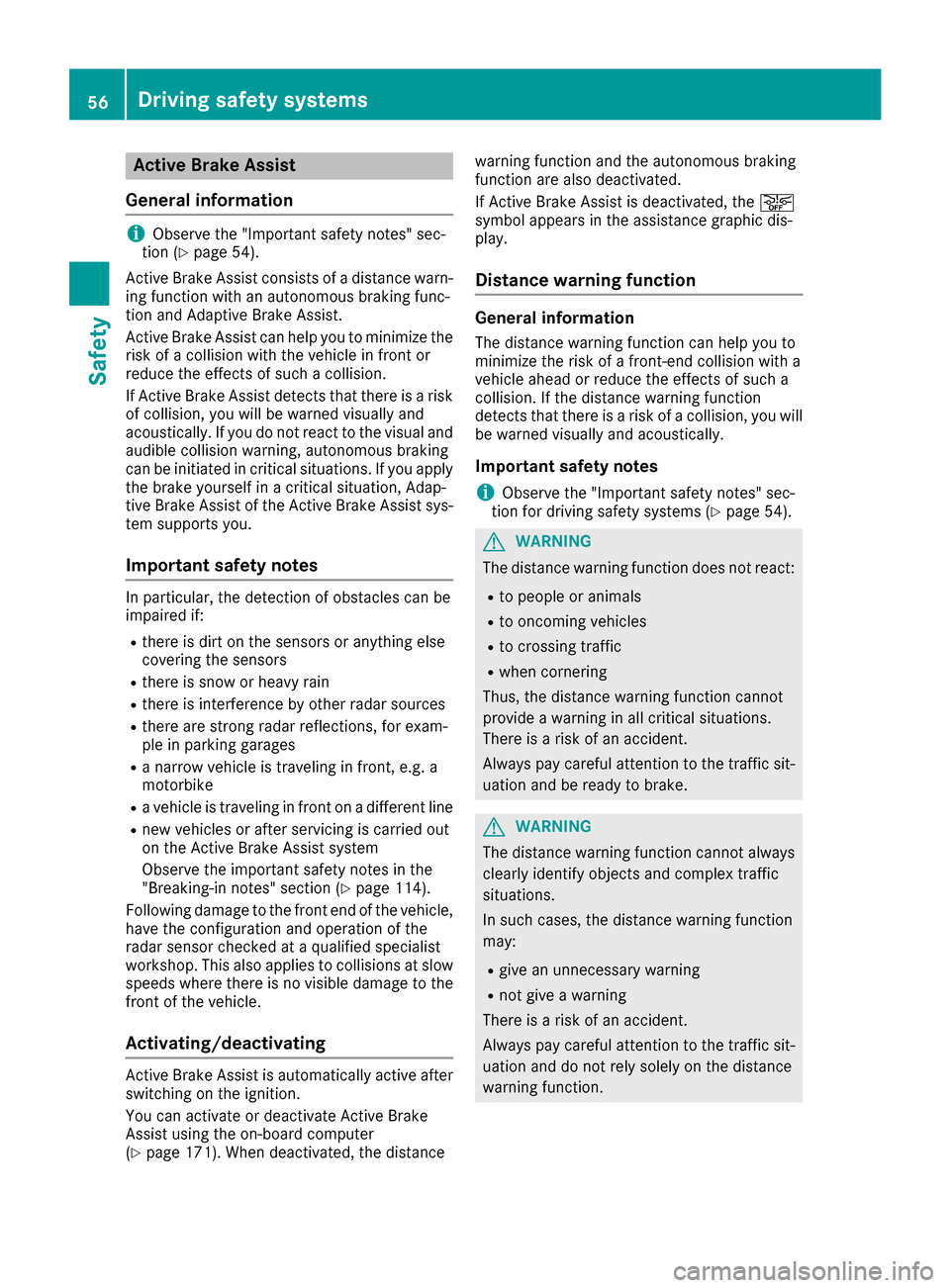
Active BrakeAssist
Gene ralinform ation
iObserv ethe "Importan tsafet ynotes "sec-
tion (Ypage 54).
Active Brake Assis tconsists ofad istanc ewarn-
ing function wit hanautonomous braking func-
tion and Adaptive Brake Assist.
Active Brake Assis tcan help you to minimiz ethe
ris kofac ollision wit hthe vehicl einfrontor
reduce th eeffects of suc hacollision .
If Active Brake Assis tdetects that there is arisk
of collision ,you will be warned visually and
acoustically. If you do no treac ttot hevisual and
audible collision warning ,autonomous braking
can be initiate dincritical situations. If you apply
th eb rak eyourself in acritical situation ,Adap-
tive Brake Assis toftheActive Brake Assis tsys-
te ms upport syou.
Import ant safety notes
In particular, th edetection of obstacles can be
impaire dif:
Rthere is dir tonthesensor soranythin gelse
covering th esensor s
Rthere is snow or heav yrain
Rthere is interferenc ebyother radar source s
Rthere are strongradar reflections, for exam-
ple in parking garages
Ran arrow vehicl eistraveling in front, e.g. a
motorbik e
Ravehicl eistraveling in fron tonadifferentlin e
Rne wv ehicles or after servicing is carrie dout
on th eActiv eBrake Assis tsystem
Observ ethe important safet ynotes in the
"Breaking-in notes" section (
Ypage 114).
Followin gdamag etothefron tend of th evehicle,
hav ethe configuration and operation of th e
radar sensor checke dataqualified specialis t
workshop .This also applie stocollision satslow
speeds wher ethere is no visible damag etothe
fron toft hevehicle.
Activating/deactivating
Active Brake Assis tisautomatically active after
switching on th eignition .
You can activat eordeactivat eActiv eBrake
Assis tusin gthe on-board computer
(
Ypage 171). When deactivated, th edistanc ewarning function and th
eautonomous braking
function are also deactivated.
If Active Brake Assis tisdeactivated, th eæ
symbol appear sintheassistanc egraphic dis-
play.
Distance warning function
Genera linformation
The distanc ewarning function can help you to
minimiz ethe riskofaf ront-end collision wit ha
vehicl eahead or reduce th eeffects of suc ha
collision .Ifthedistanc ewarning function
detects that there is ariskofac ollision ,you will
be warned visually and acoustically.
Important safety notes
iObserv ethe "Importan tsafet ynotes "sec-
tion for drivin gsafet ysystems (Ypage 54) .
GWARNIN G
The distanc ewarning function does no treact:
Rto people or animals
Rto oncomin gvehicles
Rto crossing traffic
Rwhen cornering
Thus ,the distanc ewarning function canno t
provid eawarning in all critical situations.
There is ariskofana ccident.
Always pay careful attention to th etraffic sit -
uation and be read ytob rake.
GWARNIN G
The distanc ewarning function canno talways
clearly identify objects and comple xtraffic
situations.
In suc hcases, th edistanc ewarning function
may:
Rgiv eanu nnecessary warning
Rnotg iveaw arning
There is ariskofana ccident.
Always pay careful attention to th etraffic sit -
uation and do no trelys olely on th edistanc e
warning function .
56Driving safety systems
Safety
Page 59 of 294
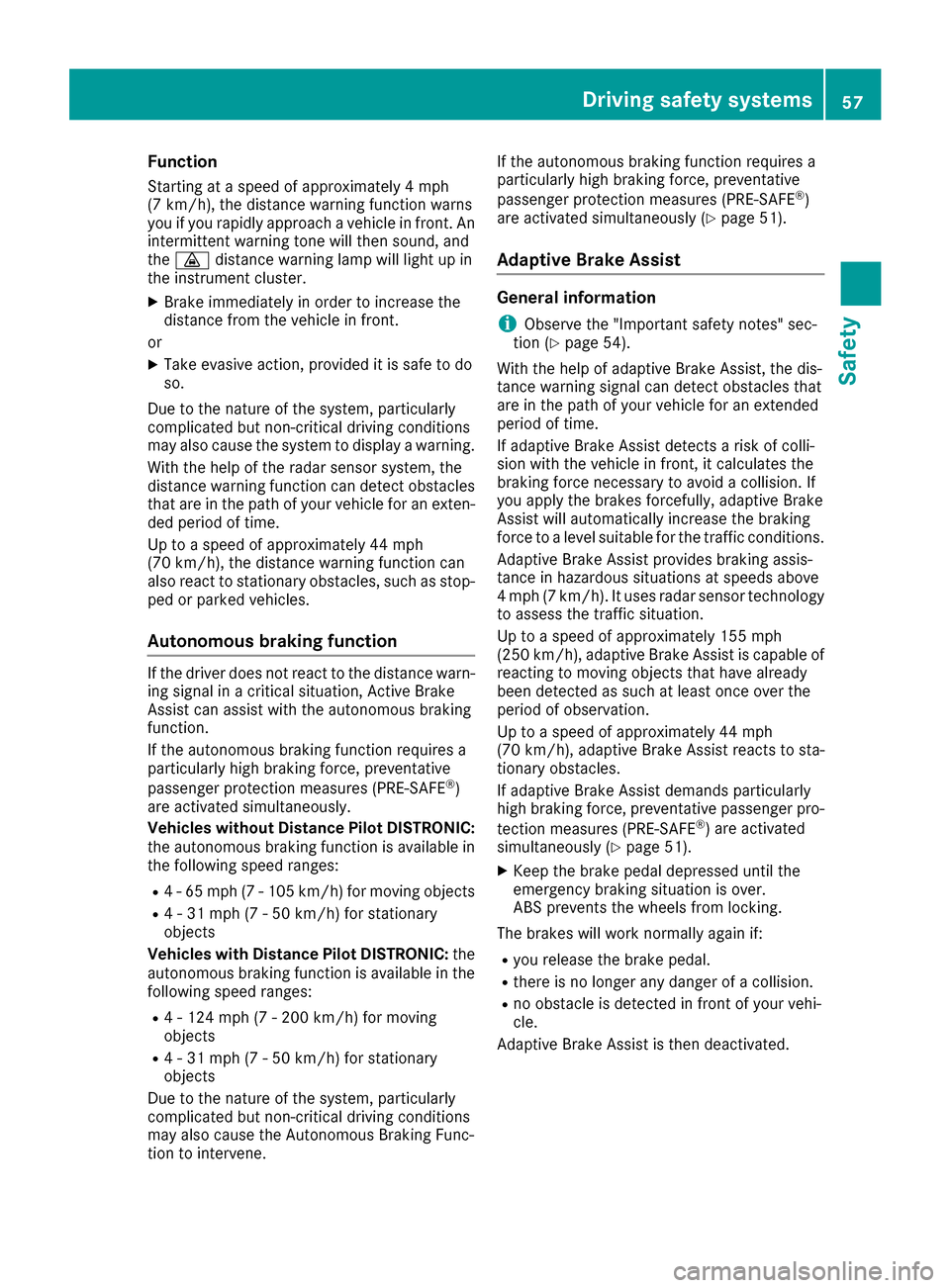
Function
Starting at aspeedofa pproximately 4mph
(7 km/h), th edistanc ewarning function warns
you ifyou rapid ly approachav ehicle in front. An
intermittentw arning tonewillthen sound, and
the · distancewarning lamp willlight up in
th ei nstrumen tcluster.
XBrake immediately inorder to increas ethe
dist ancefromt heveh icle in front.
or
XTakee vasive action,p rovide ditiss afe todo
so.
Due to th enature of th esystem, particularly
co mpli cated but non-critical driving conditions
may also caus ethe system to displayaw arning.
Witht hehelp of th eradar sensor system, the
dist ancewarning function can detect obstacles
that are inthep athofy our veh iclefor an exten-
ded period of time.
Up to aspeedofa pproximately 44 mph
(70 km/ h),t he distance warnin gfunction can
also react to stationary obstacles, such as stop-
ped or parked vehicles.
Autonomous braking function
If the driver does not react to the distance warn-
ing signal in acritical situation, Active Brake
Assis tcan assist with the autonomous braking
function.
If the autonomous brakin gfunction requires a
particularly high brakin gforce, preventative
passenger protection measures (PRE-SAFE
®)
are activated simultaneously.
Vehicles without Distance Pilot DISTRONIC:
the autonomous brakin gfunction is available in
the following speed ranges:
R4-65m ph (7-105 km/ h)for moving objects
R4-31m ph (7-50km/h)for stationary
objects
Vehicles with Distance Pilot DISTRONIC: the
autonomous braking function is available in the
following speedr anges:
R4-124 mph (7 -200 km/h )for moving
objects
R4-31m ph (7-50km/h)for stationary
objects
Due to the nature of the system ,particularly
complicated but non-critical driving conditions
may als ocaus ethe Autonomou sBraking Func-
tion to intervene. If the autonomous braking function requires a
particularly high braking force, preventative
passenger protection measures (PRE-SAFE
®)
are activated simultaneousl y(Ypage51).
Adaptive Brake Assist
General information
iObservet he "Important safety notes" sec-
tion (Ypag e54).
With the help of adaptive Brake Assist, the dis-
tance warning signa lcan detect obstacles that
are in the path of you rvehiclef or an extended
period of time.
If adaptive Brake Assist detects arisk of colli-
sion with the vehicl einfront, it calculate sthe
braking force necessary to avoi dacollision. If
you apply the brakes forcefully ,adaptive Brake
Assist wil lautomatically increas ethe braking
force to alevels uitabl efor the traffic conditions.
Adaptive Brake Assist provides braking assis-
tance in hazardouss ituations at speeds above
4m ph (7 km/h) .Itusesrada rsensor technology
to assess the traffic situation.
Up to aspeedofa pproximately 155 mph
(250 km/h) ,adaptive Brake Assist is capable of
reacting to moving objects that have already
been detected as such at least once over the
period of observation.
Up to aspeedofa pproximately 44 mph
(70 km/h), adaptive Brake Assist reacts to sta-
tionary obstacles.
If adaptive Brake Assist demands particularly
high braking force, preventative passenger pro-
tection measures (PRE-SAFE
®)a re activated
simultaneousl y(Ypage51).
XKeep the brake pedald epressed until the
emergency braking situation is over.
ABS prevents the wheels from locking.
The brakes wil lwork normally again if:
Ryou release the brake pedal.
Rthere is no longe rany dange rofacollision.
Rno obstacle is detected in front of you rvehi-
cle.
Adaptive Brake Assist is then deactivated.
Driving safety systems57
Safety
Z
Page 60 of 294
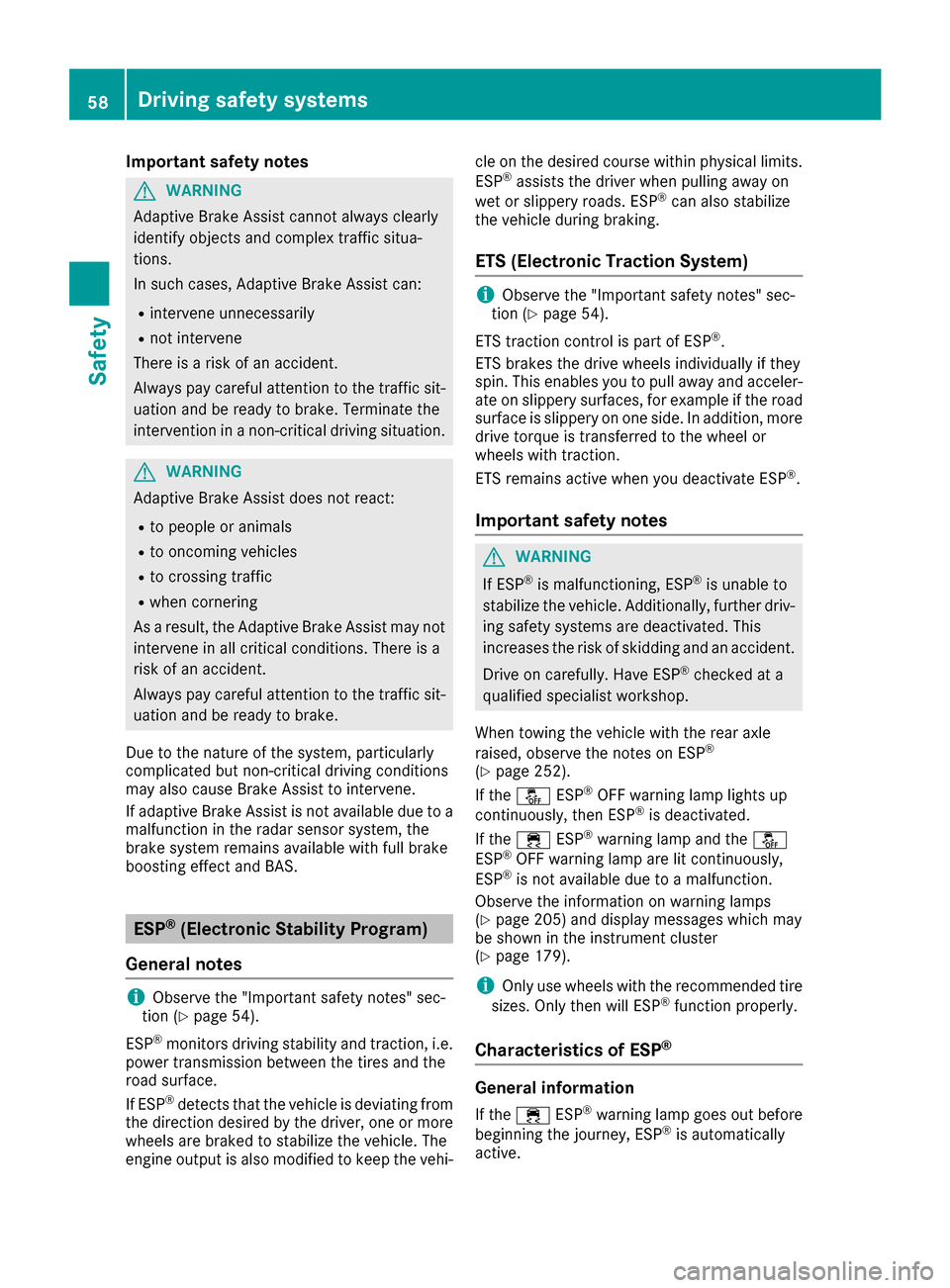
Important safety notes
GWARNING
Adaptive Brake Assist canno talways clearly
iden tifyo bject sand co mplextraffic situa-
tions.
In suchc ases, Adaptive Brake Assist can:
Rinterveneu nnecessarily
Rnotintervene
Thereisar iskofana cciden t.
Always pay careful attentio ntothetraff icsit-
uation and beread ytob rake. Terminate the
interventio ninanon-criticaldriving situation.
GWAR NING
Adaptive Brake Assist does no treact:
Rto people or animals
Rto oncomin gvehicle s
Rto crossing traff ic
Rwhen cornering
As aresult, th eAdaptive Brake Assist may not
interveneina llcritical conditions. Thereisa
ris kofana cciden t.
Always pay careful attentio ntothetraff icsit-
uation and beread ytob rake.
Due to th enature of th esystem, particularly
co mpli cated but non-critical driving conditions
may also caus eBrake Assist to intervene.
If adaptive Brake Assist isno tavailab ledue to a
malfunctio nintheradar sensor system, the
brak esystem remains availab le withfull brake
boostin geffect and BA S.
ESP®(Electronic Stability Program)
General notes
iObserv ethe "Im portan tsafety notes" sec-
tio n(Ypage 54).
ESP
®monitors driving stabilit yand traction,i .e.
power transmission between th etires and the
road surface.
If ESP
®detect stha tthe veh icle is deviating from
th ed irection desired bythed river, oneorm ore
wheelsa re braked to stabiliz ethe veh icle.The
engineo utputisalso mod ifiedtok eept he veh i- cle on th
edesired course within physical limits.
ESP
®assists th edriver when pullingaway on
wet or slippery roads. ESP®can also stabilize
th ev ehicle durin gbraking.
ETS (Electronic Traction System)
iObserv ethe "Importan tsafety notes" sec-
tio n(Ypage 54).
ET St raction control is part of ESP
®.
ET Sb rakes th edrivew heelsi ndivid ually if they
spin.T his enables you to pull away and acceler-
ate on slippery surfaces, for example if th eroad
surface is slippery on ones ide.Inaddition,m ore
drivet orque istransferred to th ewheel or
wheelsw itht raction.
ET Sr emains active when you deactivate ESP
®.
Important safety notes
GWARNING
If ESP
®is malfunctioning, ESP®is unab leto
stabilizet hevehicle .Add itionally, further driv-
ing safety systems are deactivate d.This
increases th eriskofs kiddin gand an accident.
Drive on carefully. Hav eESP
®checked at a
qualified specialist workshop.
When to wingthe vehicle witht herear axle
raised, observ ethe note sonE SP
®
(Ypage 252).
If the å ESP®OFFw arning lamp lightsu p
continuously, then ESP®is deactivate d.
If the ÷ ESP®warning lamp and the å
ESP®OFFw arning lamp are lit continuously,
ESP®is no ta vailab ledue to amalfunction.
Observ ethe information on warning lamps
(
Ypage 205) and display messagesw hichmay
be shown in thei nstrumen tcluster
(
Ypage 179).
iOnly use wheelsw itht he recommended tire
sizes. Only then willESP®function properly.
Characteristics of ESP®
General information
Ifthe ÷ ESP®warning lamp goes out before
beginnin gthe journey, ESP®is automatically
active.
58Driving safety systems
Safety